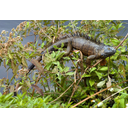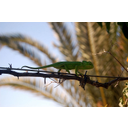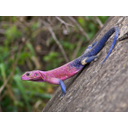Iguania
Iguania - iguanas, chamaeleons, and agamids
| Lepidosauria; Squamata; Iguania |
To learn more about their place in squamate phylogeny, please return to the Squamata main
page.
Diversity and Lower Taxonomy
Like most other
squamate groups, the taxonomy of the over 1550 species-rich Iguania has long
been a topic of dispute. An early classification of the Iguania by Charles Camp
in 1923 defined three families:
- Iguanidae - Approximately 956 species of iguanas, anoles,
horned lizards, collared lizards, and relatives.
- Chamaeleonidae - Approximately 178 species of chamaeleon.
- Agamidae - Approximately 416 species of agamid,
such as the gliding Draco, and the thorny devil Moloch horridus.
This simple classification remained for over 50 years, but
there became a strong need to readdress these relationships in a phylogenetic
framework, i.e. one that uses cladistics to understand evolutionary history by identifying monophyletic groups, or clades. This led Etheridge and de Queiros (1988) to examine the
contents of the family Iguanidae and, through analysis of morphological
characteristics, identify eight major groups within. These were the subfamilies Corytophaninae (helmet lizards), Crotaphytinae (collared lizards),Hoplocercinae (dwarf and spiny tail iguanas), Iguaninae (iguanas), Oplurinae (Madagascan iguanas), Phrynosomatinae (spiny lizards, horned lizards, and
relatives), Polychrotinae (anoles), andTropidurinae (neotropical ground lizards).
After further
study, however, Frost and Etheridge (1989) failed to find sufficient support
for the monophyly of Iguanidae, and so proposed to raise the eight subfamilies to family
status (all had the same name but with a -dae suffix rather than a -nae
suffix). While some authors still use this taxonomy, many refute it. For
example, Macey et al. (1997) found strong support for the monophyly of the traditional Iguanidae using a combined morphological
and DNA sequence analysis, and proposed that the families promoted by Frost and
Etheridge (1989) be returned to their initial statuses as subfamilies of
Iguanidae. This was corroborated by more comprehensive combined analyses by
Schulteet al. (1998, 2003), who also brought into question the monophyly of two of the subfamilies of the Iguanidae, the Tropidurinae
and Polychrotinae. The monophyly of all the remaining subfamilies was strongly supported,
although the phylogenetic interrelationships between these subfamilies failed
to be reconciled.
The sister group to
the Iguanidae is the monophyletic Acrodonta (Estes et al. 1998). This contains the remaining
iguanians: the chamaeleons and agamids. Within the Acrodonta, studies such as
Maceyet al. (1997,
2000) have found little statistical support for the monophyly of the traditional family Agamidae. That is, some agamids may
be more closely related to the chamaeleons than to other agamids. Nonetheless,
it is useful to use the term Agamidae in the meantime, as what is termed ametataxon - a traditionally recognised group whose monophyly is statistically uncertain. Macey et al.(2000) defined six agamid subfamilies:
- Agaminae - the African-West Asian clade of agamids, containing 6
genera, including Agama.
- Amphibolurinae - the clade comprising the Chinese
water dragon, Physignathus
cocincinus, plus all Australian or New Guinean agamids, in 14 genera.
- Draconinae - the South Asian clade of agamids, containing 14
genera, including the gliding Draco.
- Hydrosaurinae - the sailfin lizards, Hydrosaurus.
- Leiolepidinae - the butterfly lizards, Leiolepis.
- Uromastycinae - the spiny-tailed lizard, Uromastyx.
The following cladogram illustrates the evolutionary history of these taxa, as proposed by Macey et al.(2000). While the monophyly of the subfamilies was well supported, the among group
phylogenetic relationships and the monophyly of Agamidae shown in the diagram received little statistical
support.

The chamaeleons, on
the other hand, remain in the monophyletic clade Chamaeleonidae. This family is divided into two subfamilies, Brookesiinae (containing three genera, including Brookesia) andChamaeleoninae (containing 6 genera, including Chamaeleo).
Description
The iguanids.
Living agamids are a highly diverse group of average to
large-sized lizards with a wide range of specialisations. As a result, it would
be difficult to describe the appearance of a "typical" agamid. For
example, members of the South Asian arboreal genus Draco (subfamily Draconinae) have evolved extremely
elongate, protruding ribs, which stretch the skin out into two wing-like patagial membranes, allowing individuals to perform extensive glides
between trees (recorded as far as 60 m, with only a 10 m descent). Some groups possess
modified spiny scales, which may cover the body (as in the Australian thorny devil, Moloch horridus) or the tail (as in members of the genus Uromastyx), while another group, the Southeast Asian sailfin lizards (Hydrosaurus), possess a laterally compressed dorsal extension of the tail, making them proficient swimmers.
Most agamids are
diurnal, feeding mainly on insects and other small prey. A few, e.g. Uromastyx, are partly herbivorous. They are all oviparous, except for
members of the genus Phrynocephalus, which give birth to live young (viviparous).
The chamaeleons are a familiar and charismatic group of lizards,
with a large suite of unique physical characteristics making them extremely
distinct. Ranging in size from around 2.5 cm (e.g. Brookesia spp.) to over 50 cm (e.g. Furcifer oustaleti), they are probably most famous for their ability to change
colour - made possible by the presence of specialised chromatophores (cells containing pigment that reflect light) in
the skin - which is often used in social signalling. The body of a chamaeleon
is laterally compressed, and the head often bears many horns
and ridges. These features are likely to play a role in sexual selection, as
males are usually considerably more ornamented than females.
Chamaeleons are
highly specialised for arboreal life. Not only do they have a strong grasping prehensile tail, but their feet are zygodactylus - meaning that two digits face forwards and two
face rearwards, allowing a firm grip on a branch. In addition, they have an
extremely long, rapidly protractable tongue, with which insect prey can be
seized efficiently from a distance often as far away as the length of their own
body. This kind of accuracy is afforded by the positioning of their eyes, which
are bulbous and protruding, allowing the two fields of vision to overlap and
result in stereopsis(depth perception). The eyes can also be moved independently.
The tip of the tongue is highly muscular and covered in mucus, forming a
suction cup that is extremely difficult for prey to escape.
Distribution and Habitat
Iguanids
Agamids are distributed
throughout Asia, Oceania, Africa, and
Chamaeleons are mainly found in
Africa and
Conservation Status (IUCN)
There are 223
species of iguanid present on the IUCN Red List. Almost 25% of these
are recognised as either Critically Endangered (CR; 5%), Endangered (EN; 7%), or Vulnerable (VU; 12%). Thankfully, the majority (55%) are considered Least Concern (LC). The remainder are
either Near Threatened (NT; 4%) or Data Deficient (DD; 17%).
Only 13 of the 416
species of agamid are present on the Red List. Of these, 2 are Critically Endangered (CR), whilst 2 are Endangered (EN), and 3 are Vulnerable (VU). Of the remaining 6 species, 2 are Data Deficient (DD), and the rest are Lower Risk (LR) - either Near Threatened (NT) or Least concern (LC).
There are 9 species
of chamaeleon on the Red List. Smith's dwarf chamaeleon, Bradypodion
taeniabronchum, is the only Critically Endangered (CR) species. Of the rest, 2 are Endangered
(EN), 4 are Vulnerable (VU), and 2 are Near Threatened (NT).
Synapomorphies of the Iguania and Acrodonta
- Iguania:
- Postfrontal either reduced or
absent.
- Anteroventral margin
of the orbit formed by the jugal.
- Ridges near the orbital margin.
- Frontal shelf underlying the
nasal.
- Pineal foramen located on the
frontoparietal suture or within frontals.
- Articular separate from
prearticular and surangular.
- A contact between the jugal and squamosal along the upper temporal arch.
- Postfrontal either reduced or
absent.
- Acrodonta
- Acrodont dentition.
- No replacement teeth.
- Postfrontal absent.
- Contact between palatines
across the entire midline.
- No intravertebral fracture
planes for caudal autotomy.
- No depression on ventral surface
of the pterygoid.
- Unique mitochondrial gene order, involving the
rearrangement of two tRNA genes - a molcular synapomorphy.
- Acrodont dentition.
Licensed under the Creative Commons Attribution Non-commercial Share Alike 3.0 License
'Vertebrate Diversity' has been released as an open educational resource (OER) on a Creative Commons 'Attribution Non-commercial Share Alike' license. This means that once downloaded, content can be modified and improved to complement a particular course. This requires, however, that improvements are recycled back into the OER community. All content present at the time of download must be accordingly credited and, in turn, novel content must be appropriately licensed. For more information, please refer to the license deed by clicking on the link above.


